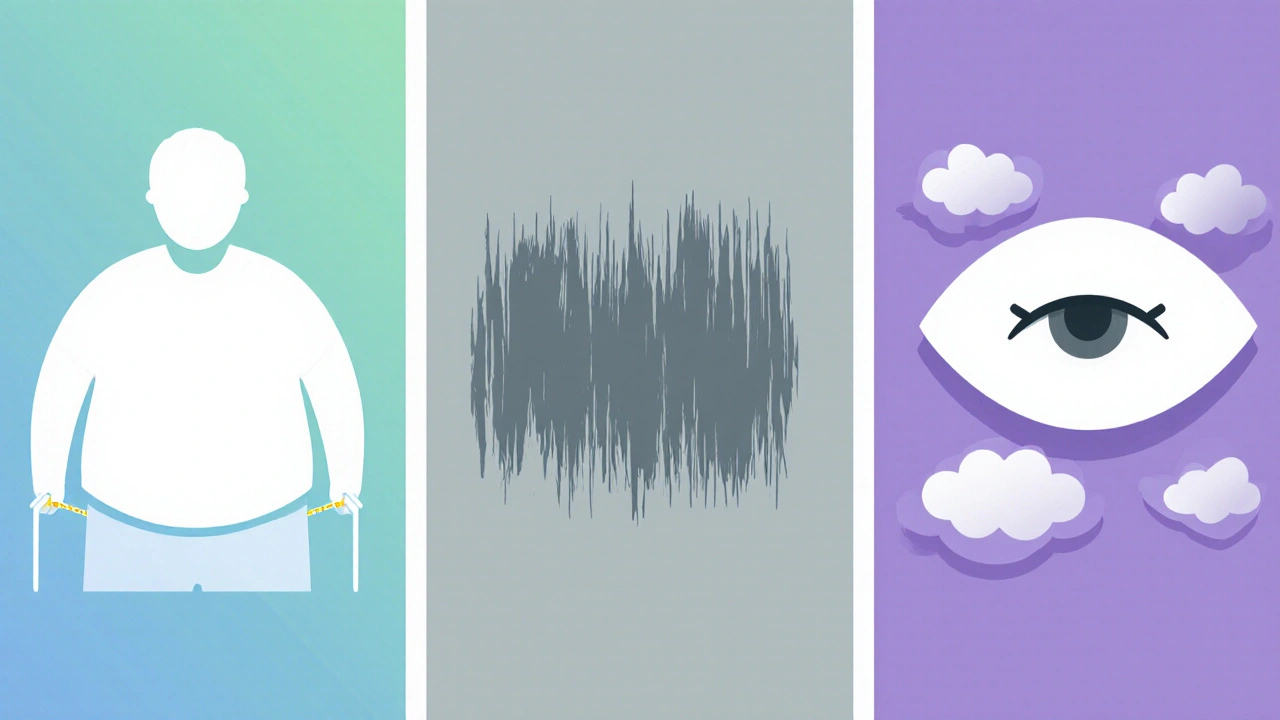Antipsychotic Medication Comparison Tool
Interactive Guide: Select a medication below to compare its key characteristics with Olanzapine. This tool helps understand the trade-offs between efficacy, side effects, and clinical considerations.
Olanzapine
High Efficacy
- Weight Gain: ~4.5 kg/year
- Sedation: Moderate
- Key Risks: Metabolic syndrome, sedation
Risperidone
Moderate Weight Gain
- Weight Gain: ~1.2 kg/year
- Sedation: Low
- Key Risks: Prolactin elevation, EPS
Quetiapine
Moderate Weight Gain
- Weight Gain: ~2.0 kg/year
- Sedation: High
- Key Risks: Daytime drowsiness, orthostatic hypotension
Aripiprazole
Lowest Weight Gain
- Weight Gain: ~0.8 kg/year
- Sedation: Low
- Key Risks: Akathisia, insomnia
Clozapine - Special Considerations
- Efficacy: Very High (gold standard for treatment-resistant cases)
- Weight Gain: ~5.0 kg/year
- Key Risks: Agranulocytosis, myocarditis
- Monitoring: Regular blood tests required
Clinical Decision Guide
- Start with Risperidone or Aripiprazole for minimal metabolic concerns
- Consider Olanzapine or Quetiapine for rapid mood stabilization
- Use Clozapine only for treatment-resistant cases
- Avoid high-potency agents if patient has EPS history
- Factor in patient preferences regarding side effects
Quick Tips for Managing Side Effects
- Weight gain: Monitor BMI quarterly; encourage healthy diet and exercise
- Glucose spikes: Check fasting glucose every 3 months; consider metformin if needed
- EPS: Use Simpson-Angus Scale; low-dose benztropine may help
- Sedation: Take at bedtime; adjust dose if daytime drowsiness occurs
When it comes to managing schizophrenia or bipolar I disorder, many clinicians start the conversation with Olanzapine. It’s a well‑known atypical antipsychotic, but it isn’t the only option on the table. Understanding how it stacks up against other drugs can save patients from unwanted side effects and help doctors choose the most suitable therapy.
Key Takeaways
- Olanzapine is highly effective for acute psychosis but often causes weight gain and metabolic issues.
- Risperidone, Quetiapine, Aripiprazole, and Clozapine each offer a different balance of efficacy and side‑effect risk.
- Choosing the right medication depends on diagnosis, prior response, comorbid conditions, and personal tolerance for side effects.
- Regular monitoring of weight, glucose, and lipid levels is essential when using Olanzapine or similar agents.
- Shared decision‑making between patient and provider leads to better adherence and outcomes.
What Is Olanzapine?
When doctors discuss second‑generation antipsychotics, Olanzapine is a pivotal atypical medication approved for schizophrenia and bipolar I disorder. First launched in 1996, it works by blocking dopamine D2 and serotonin 5‑HT2A receptors, which helps reduce hallucinations, delusions, and mood swings.
How Olanzapine Works
The drug’s dual antagonism dampens the overactive dopamine pathways linked to psychosis while also modulating serotonin activity that influences mood and anxiety. This balance often translates into fast symptom control, especially during acute episodes. However, the same receptor profile can trigger histamine H1 and muscarinic blockade, contributing to sedation and appetite increase.

Common Alternatives
Below are the most frequently considered alternatives, each with its own pharmacologic fingerprint.
Risperidone - a versatile atypical
Approved in 1993, Risperidone blocks D2 and 5‑HT2A receptors like Olanzapine but has a lower affinity for H1, meaning less weight gain. It’s often chosen for patients who need a strong antipsychotic effect without pronounced metabolic side effects.
Quetiapine - a sedating option
Quetiapine, introduced in 1997, has a broader receptor profile that includes alpha‑1 adrenergic antagonism. This makes it useful for patients with insomnia or anxiety, but it can also cause daytime drowsiness.
Aripiprazole - a partial agonist
Aripiprazole, marketed since 2002, uniquely acts as a dopamine partial agonist. It tends to produce fewer metabolic issues and can even improve depression symptoms, though some patients experience akathisia (restlessness).
Clozapine - the gold standard for treatment‑resistant schizophrenia
Clozapine, the oldest atypical (approved 1989), is reserved for patients who have not responded to at least two other antipsychotics. Its efficacy is unmatched, but it requires regular blood monitoring due to a risk of agranulocytosis.
Side‑Effect Landscape
To compare the safety profiles, consider three major domains: metabolic changes, extrapyramidal symptoms (EPS), and sedation.
- Metabolic Side Effects - Olanzapine and Clozapine lead the pack in weight gain and glucose elevation.
- EPS - Risperidone and Haloperidol (a typical antipsychotic not detailed here) have higher rates of tremor and rigidity.
- Sedation - Quetiapine and Clozapine are the most sedating, while Aripiprazole is the least.
Comparison Table
| Medication | FDA Approval Year | Typical Daily Dose | Efficacy (CGI‑Improvement) | Weight Gain (kg/yr) | Key Risks |
|---|---|---|---|---|---|
| Olanzapine | 1996 | 5‑20mg | High | ~4.5 | Metabolic syndrome, sedation |
| Risperidone | 1993 | 1‑6mg | High | ~1.2 | Prolactin elevation, EPS |
| Quetiapine | 1997 | 300‑800mg | Moderate | ~2.0 | Daytime drowsiness, orthostatic hypotension |
| Aripiprazole | 2002 | 10‑30mg | Moderate‑High | ~0.8 | Akathisia, insomnia |
| Clozapine | 1989 | 300‑900mg | Very High | ~5.0 | Agranulocytosis, myocarditis |

How to Choose the Right Antipsychotic
Think of the decision as a balance scale. On one side you place efficacy-how well the drug controls psychosis. On the other side you add tolerability, cost, and monitoring requirements. Below is a quick decision flow:
- If the patient has schizophrenia with minimal metabolic concerns, start with Risperidone or Aripiprazole.
- If rapid mood stabilization is essential (e.g., bipolar mania), Olanzapine or Quetiapine can be considered, but set up weekly weight checks.
- For treatment‑resistant cases, move to Clozapine after failing two other agents.
- When a patient has a history of EPS, avoid high‑potency agents like Risperidone; favor Aripiprazole or Quetiapine.
- Always factor in patient preference-some will accept weight gain for smoother mood control, others will not.
Managing Common Side Effects
Regardless of the chosen drug, proactive monitoring makes a huge difference.
- Weight gain: Schedule baseline BMI and repeat every 3months. Encourage low‑glycemic meals and moderate exercise.
- Glucose spikes: Perform fasting glucose at baseline, then quarterly. If levels rise, consider metformin adjunct therapy.
- EPS: Use the Simpson‑Angus Scale at each visit. Low‑dose benztropine can blunt rigidity if needed.
- Sedation: Advise taking the medication at night. If daytime sleepiness persists, lower the dose or switch to a less sedating option.
Frequently Asked Questions
Can I switch from Olanzapine to another antipsychotic without a washout period?
A direct cross‑taper is usually preferred. Start the new drug at a low dose while gradually decreasing Olanzapine over 1‑2weeks. This approach reduces relapse risk and limits withdrawal symptoms.
Why does Olanzapine cause so much weight gain compared to Aripiprazole?
Olanzapine strongly blocks histamine H1 and serotonin 5‑HT2C receptors, both of which regulate appetite and metabolism. Aripiprazole’s partial agonist activity spares these pathways, leading to a lighter weight profile.
Is Clozapine ever used as a first‑line treatment?
Because of its rare but serious blood‑disorder risk, Clozapine is reserved for patients who have failed at least two other antipsychotics. It is not a first‑line choice.
How often should labs be drawn while on Olanzapine?
Baseline fasting glucose, lipid panel, and HbA1c are recommended. Repeat these tests at 3‑month intervals for the first year, then semi‑annually if stable.
Can pregnant women take Olanzapine safely?
Data are limited, but most guidelines consider Olanzapine relatively safe if benefits outweigh potential risks. Discuss dosing and fetal monitoring with an obstetric psychiatrist.
Choosing an antipsychotic is rarely a one‑size‑fits‑all decision. By weighing efficacy, side‑effect propensity, and individual health factors, patients and providers can land on a regimen that offers symptom control without compromising quality of life.

